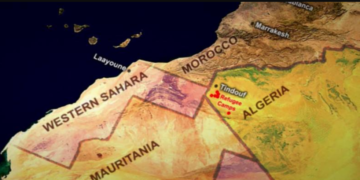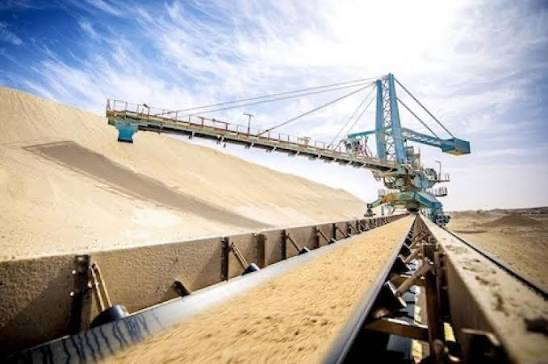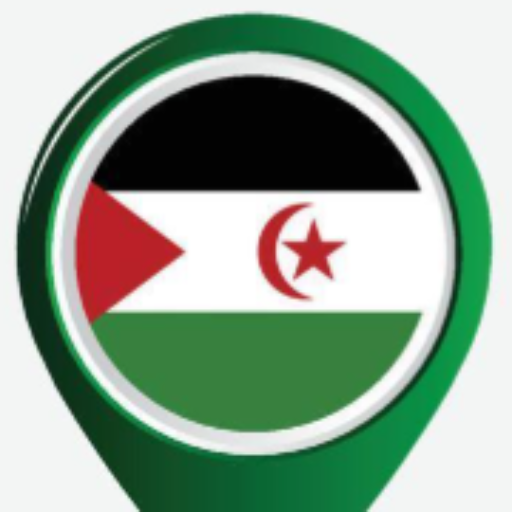Since the discovery of rich mineral deposits across Western Sahara, the region has become a focal point of colonial and economic ambitions. The vast underground resources buried beneath its sands first attracted Spanish colonial interests, and later became one of the main motives behind Morocco’s occupation following Spain’s withdrawal in 1975.
⸻
Bou Craa Phosphate: The Economic Heart of Western Sahara
Industrial phosphate extraction in Bou Craa began in 1974, marking the start of one of the world’s largest mining operations. The Bou Craa mine contains over 9% of the world’s phosphate reserves and about 15% of Africa’s total phosphate resources, placing Western Sahara third globally after Morocco and the United States.
A 100-kilometer-long conveyor belt—the longest of its kind in the world—transports the phosphate from the mine to the Atlantic Ocean, with an annual output of around 20 million tons.
During the Spanish colonial period, the high-grade phosphate—often exceeding 80% purity—enabled Spain to earn more than $660 million, with profits reaching up to 70%, thanks to the mineral’s surface accessibility and proximity to the coast, which minimized production and transport costs.
Even after withdrawing from the territory, Spain retained 35% of FosBoucraa’s shares through a secret trade deal with Morocco, ensuring a continued supply of phosphate, mainly for fertilizer and phosphoric acid production.
⸻
Moroccan Occupation and Resource Exploitation
Since Morocco’s invasion of Western Sahara in 1975, the occupying authorities have imposed strict secrecy over phosphate extraction data. Nonetheless, international estimates suggest that Morocco currently extracts about 7 million tons annually from Bou Craa—roughly 35% of its total national output—with plans to increase production to 10 million tons in the coming years.
Phosphate from Western Sahara is used in a variety of industries, including:
• Agricultural fertilizers.
• Metallurgical, ceramic, and textile industries.
• Food and military industries.
• Medical and chemical sectors.
• And notably, uranium extraction—each ton of Saharan phosphate contains around 200 grams of uranium.
In fact, in 1982, the Moroccan authorities extracted uranium from Saharan phosphate as part of their energy and nuclear research initiatives.
⸻
Other Hidden Mineral Treasures
Beyond phosphate, Western Sahara is home to a wide range of valuable mineral resources, many of which remain untapped due to political and territorial circumstances.
1. Iron, Titanium, and Vanadium
Western Sahara holds an estimated 4.6 billion tons of iron ore, with iron content ranging from 38% to 65%—a grade suitable for direct use in steelmaking without refining.
In the Agrascha deposit alone, there are approximately 10 million tons of titanium and over half a million tons of vanadium, two strategic elements used in aerospace, electronics, and precision manufacturing.
2. Rare Earth Elements
A study conducted at the Geological Research University in Moscow (Russia) on samples from Agwenit (Tiris) revealed remarkably high concentrations of rare and strategic elements:
• Titanium oxide – 30%
• Zirconium oxide – 30.34%
• Thorium oxide – 1.04%
• Niobium oxide – ~1%
• Total rare earth oxides – 15.76%, including cerium, neodymium, lanthanum, and praseodymium.
These rare earth elements (REEs) are vital for modern technologies, military applications, renewable energy, and nuclear and space industries.
3. Copper and Gold
Significant copper deposits exist in the regions of Adrar Soutaf and Saguia el-Hamra, while gold-bearing formations have been discovered in Oued Eddahab and near the Agwiyet area, where one copper mine contains up to 1% gold.
4. Additional Minerals
Preliminary geological surveys also point to potential deposits of uranium, tin, manganese, tungsten, chromium, magnesium, and zircon—resources of major industrial and strategic value.
⸻
Gemstones and Salt Deposits
Western Sahara is rich in precious and semi-precious stones, including emerald, sapphire, amethyst, malachite, lapis lazuli, quartz, and antimony (stibnite), particularly in the Amseid Lekh’l area near Laayoune. These stones have long been used for traditional Sahrawi jewelry and decorative crafts.
As for rock salt, the territory hosts 42 natural salt flats (Sebkhas), nine of which are currently exploited through traditional methods. Together, they produce more than 4.5 million tons of salt annually, providing jobs for over 5,000 workers.
For instance, Sebkha Oum Dheb’a generates daily revenues of about $7,000.
Salt from Western Sahara is used in:
• Food and pharmaceutical industries.
• Soap, dyeing, and leather tanning.
• Agriculture and animal feed production.
• Oil refining, refrigeration, and detergents.
⸻
Western Sahara: The Forgotten Land of Wealth
Geological and scientific research confirms that Western Sahara possesses some of the richest mineral reserves in Africa, if not the world. Yet, these resources are continuously exploited without the consent of the Sahrawi people, and with no benefit returned to them.
From phosphate to uranium, and from gold to rare earth elements, the land of Western Sahara remains a symbol of systematic plunder—a region whose true wealth awaits liberation and rightful sovereignty by its people.
⸻
Western Sahara resources, Bou Craa phosphate, Sahrawi natural wealth, Moroccan occupation, phosphate mining, rare earth elements, uranium in Western Sahara, gold and copper deposits, Sahrawi economy.







